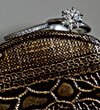eleGALA tip
Our wedding ring savings guide offers many useful tips to help you get costs down.
All About Wedding Rings
Shopping for wedding rings involves slightly more than picking out a strand of beads. We’ve narrowed down the steps to choosing a wedding ring you’ll love.
Choose Your Style
What’s your function
Since this is a ring you’ll wear every day, it must match your lifestyle. Super active? Work with your hands? Opt for a simple metal ring with rounded edges, appropriately named a “comfort fit,” instead of a wide detailed band or one with stones. If you have skin allergies to metal alloys (found in gold bands), you’ll need to invest in platinum – a pure, hypoallergenic metal.
Mix it up
Concerned that he likes white gold and you prefer platinum? Relax; your bands don’t necessarily have to match. What matters is that both of you have a ring you’ll enjoy wearing.
Test of time
Wedding rings are not the accessory for paying homage to the fad gods. Make sure to select a classic style that won’t look dated decades down the road.
Pick your metals
Platinum
Great because…
It’s valuable: King Louis declared platinum the only metal fit for a king, need we say more?
It’s durable: Platinum is resistant to tarnish and great for holding prong settings.
It’s hypoallergenic: Platinum is 90–95% pure and won’t irritate the skin.
The downside…
It’s expensive: It’s rare, making it more price sensitive.
It’s malleable: Platinum nicks and scratches easily; however, since no metal is lost, it can be buffed to look good as new.
Gold
Great because…
It’s traditional: Gold has withstood the test of time to be the most common wedding ring metal.
It’s less expensive: Gold is more abundant than platinum, making it more affordable.
The downside…
It’s not as pure: Gold is always mixed with metal alloys (copper, silver, nickel) to make it stronger. The lower the karat, the higher the percentage of other metals.
It’s soft: Making it susceptible to denting. The higher the karat, the more pure – and therefore softer – it is. If you’re highly active and not planning to purchase platinum, you may want to consider a lower karat gold.
It’s not as pure: Gold is always mixed with metal alloys (copper, silver, nickel) to make it stronger. The lower the karat, the higher the percentage of other metals.
It can irritate skin: Metal alloys can cause allergic reactions.
Titanium
Great because…
It’s hypoallergenic.
It’s strong – three times stronger than steel.
It’s inexpensive.
The downside…
It can’t be resized.
Silver
Great because…
It’s the least expensive precious metal.
The downside…
It’s extremely soft: Even when combined with other metals, it shows wear over time.
It can irritate skin: Usually combined with nickel to make it stronger, silver can cause skin irritations.
Examine Your Budget
Since metal selection is so closely tied to cost, you’ll need to examine your budget before you get too carried away with your preferences.
For a plain gold band
Prices range from about $100–$200.
For a simple platinum band
Prices run between $400–$1,000.
For a band with diamonds
Prices vary widely depending on the metal and quality of stones you choose, but the cost of an average diamond wedding band is about $1,000.
Engraving Your Band
Engraving can cost from $1 to $8 per character. Actual cost depends on the font and whether it’s engraved by hand or machine.
Browse Before You Buy
Start your wedding ring search at least two months before your wedding day – and even earlier if you want a custom piece or engraving (which can take up to one month). Just like any other big-ticket purchase, avoid the urge to buy the first thing you see; browsing is a vital part of the ring selection process.
Size Your Wedding Band
Remember that your fingers continuously swell and contract due to ongoing factors like heat, cold, weight gain/loss, water retention, etc., so you’ll need to find a size that will fit comfortably through it all. Select your size when you’re relaxed and have a normal body temperature, and avoid making your final decision in the morning, after exercising, or when you’re feeling very hot or cold.





